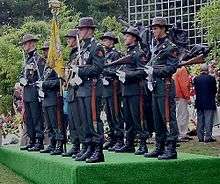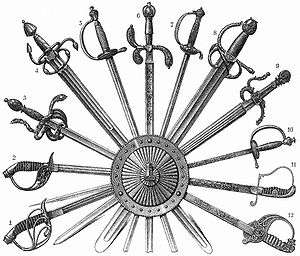Klewang
| Klewang | |
|---|---|
 South Sumatran klewang, pre-1889 | |
| Type | Cutlass |
| Place of origin | Indonesian archipelago |
| Service history | |
| Wars |
Aceh War Indonesian National Revolution |
| Specifications | |
| Length | 40–70 cm |
|
| |
| Blade type | Single edge, slight convex grind |
| Hilt type | Water buffalo horn, wood |
| Scabbard/sheath | Wood |
The klewang or kelewang is a class of cutlass weapon between the sword and machete originating in Indonesia but also found in Malaysia.
History

During the Aceh War the Acehnese klewang proved very effective in close quarters combat against the cutlass-wielding Dutch troops and the Royal Netherlands East Indies Army. Mobile troops armed with carbines and klewang succeeded in suppressing Aceh resistance where traditional infantry with rifle and bayonet had failed. From that time on until the 1950s the Royal Dutch East Indies Army, Royal Dutch Army, Royal Dutch Navy and Dutch police used these cutlasses called klewang.
Even from the time after Aceh was pacified by the Dutch to the 1930s and right through World War II, lone wolves Acehnese without generals would still attack Europeans in hopes of getting martyred themselves in order to attain paradise. Weapons used in such cases are usually the klewang, if not the Rencong.[1]
Ceremonial use

In the Royal Netherlands Army the klewang is still used as a ceremonial weapon by the colour guard of the Regiment van Heutsz which took over the traditions of the Royal Netherlands East Indies Army, where the klewang was historically used as a side arm.
Description
The klewang features a single-edge blade with a protruding notch near its tip.[2] In size, weight and shape it is halfway between the golok and the kampilan. The style of the klewang differs between the various cultures of Indonesia. Blades range from 15 to 30 inches (38 to 76 cm) in length and may be straight or slightly curved.[3] It is carried for show by followers of chiefs, or taken on expeditions to market or nightly walks in the villages. It is worn without a sheath[4] although there are sheathed varieties.
In Malaysia, the klewang may be found in various states. The Kelantanese klewang features a curve blade with a spike, and was worn by men in the 19th century at the back of the sarong with the blade protruding.[5]
See also
References
- ↑ James T. Siegel (2011). Objects and Objections of Ethnography. Fordham Univ Press. p. 88. ISBN 08-232-3274-3.
- ↑ Weapons and fighting arts of Indonesia, Donn F. Draeger, Tuttle Publishing, Apr 15, 1992 p.33
- ↑ Albert G Van Zonneveld (2002). Traditional Weapons of the Indonesian Archipelago. Koninklyk Instituut Voor Taal Land. ISBN 90-5450-004-2.
- ↑ Christian Snouck Hurgronje (1901). The Acehnese, Volume 1. Book On Demand. ASIN B005G1O9SM.
- ↑ Farish Noor & Eddin Khoo (2012). Spirit of Wood: The Art of Malay Woodcarving. Tuttle Publishing. ISBN 14-629-0677-X.
External links
| Wikimedia Commons has media related to Klewang. |
- "Het ontstaan van de militaire Klewang (in Dutch)" (PDF). Armamentaria/Dutch Army Museum. 2008. Archived from the original (PDF) on 2011-07-24. Retrieved 2010-02-28.
